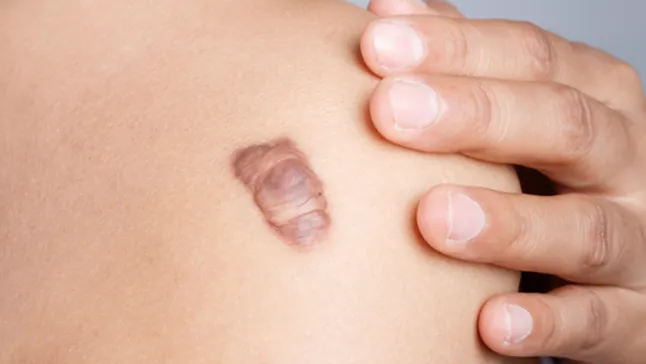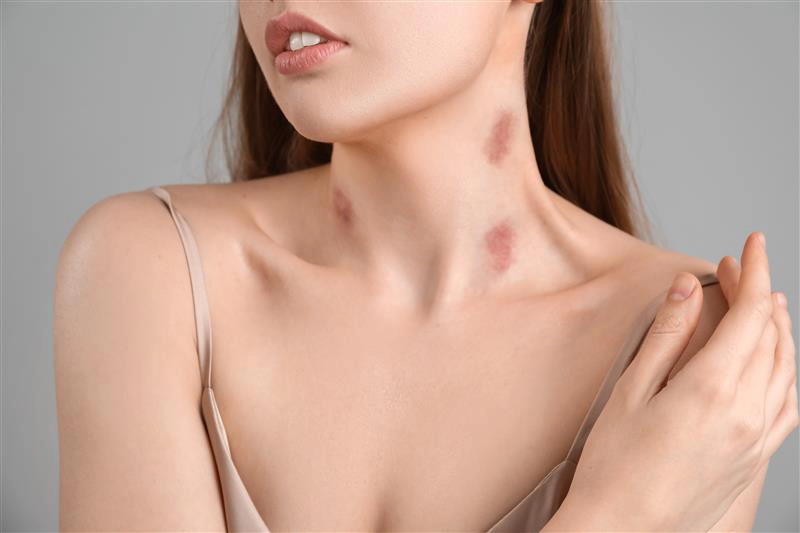What are warts?
keloids
Keloids come from the overgrowth of scar tissue. Keloid scars tend to be larger than the original wound itself. They may take weeks or months to develop fully.
Home » By concern » keloids

What are keloids?
When skin is injured, fibrous tissue called scar tissue forms over the wound to repair and protect the injury. In some cases, extra scar tissue grows, forming smooth, hard growths called keloids.
Keloids can be much larger than the original wound. They’re most commonly found on the chest, shoulders, earlobes, and cheeks. However, keloids can affect any part of the body.
Although keloids aren’t harmful to your health, they may create cosmetic concerns.
Keloid symptoms
Keloids come from the overgrowth of scar tissue. Keloid scars tend to be larger than the original wound itself. They may take weeks or months to develop fully.
The symptoms of a keloid can include:
- a localized area that is flesh-colored, pink, or red
- a lumpy or ridged area of skin that’s usually raised
- an area that continues to grow larger with scar tissue over time
- an itchy patch of skin
a localized area that is flesh-colored, pink, or red
a lumpy or ridged area of skin that’s usually raised
an area that continues to grow larger with scar tissue over time
an itchy patch of skin
Keloid scarring can form on large areas of your body, but this is generally rare. When it happens, the hardened, tight scar tissue may restrict movement.
Keloids are often more of a cosmetic concern than a health one. You may feel self-conscious if the keloid is very large or in a highly visible location, such as on an earlobe or the face.
What are the causes of keloids?
Most types of skin injury can contribute to keloid scarring. These include:
- acne scars
- burns
- chickenpox scars
- ear piercing
- Scratches
- surgical incision sites
- vaccination sites
An estimated 10 percent of people experience keloid scarring. Men and women are equally likely to have keloid scars. People with darker skin tones are more prone to keloids.

Other risk factors associated with keloid formation include:
- being of Asian descent
- being of Latino descent
- being pregnant
- being younger than 30 years of age
Keloids tend to have a genetic component, which means you’re more likely to have keloids if one or both of your parents have them.
If you have known risk factors for developing keloids, you may want to avoid getting body piercings, unnecessary surgeries, and tattoos.
How are keloids treated?
Corticosteroid injections are considered a first-line treatment for hypertrophic scars. Injecting a steroid into the scar every six weeks may help flatten and soften the scar. There’s a limit to the number of times this can be performed, however, as the steroids may also weaken normal tissue around the scar.
Laser therapy is more effective in newly formed scars than in older scars. The lasers work by burning and flattening elevated scars. They also target the red and pink pigments in the scars
Radiance Skin Clinic
Testimonials

Fantastic experience having a mole removed at Radiance!! Completely painless and done in 5 minutes. The doctor and staff are so friendly and welcoming. Highly recommend 😊
Ruby

Dr. Kitisak is very good and professional. I’m very satisfied with the result of getting treatment here. My face is beautiful and glowing. Highly recommended. Nice, clean, and convenient location of the clinic.
ohdelanna

Very good clinic. My husband and I only go to Dr. Kittisak. He is an excellent specialist and quickly helps solve any problem. The prices at the clinic are also very reasonable and low compared to other clinics.
Emilia Krutilina

I have a very sensitive skin condition, been trying numbers of clinic and treatments. Finally I found Radiance, hit the point, fix the issue. Now I’m ready to do selfie without application.
Jakapong Prachuabmoh
Make an appointment
Lorem Ipsum is simply dummy text of the printing and typesetting industry. Lorem Ipsum has been the industry’s standard dummy




